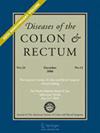What To Do With Suspected Nodal Regrowth on Magnetic Resonance Imaging During Follow-up in an Organ Preservation Approach for Rectal Cancer?
IF 3.2
2区 医学
Q2 GASTROENTEROLOGY & HEPATOLOGY
引用次数: 0
Abstract
BACKGROUND For nodal regrowth in patients with rectal cancer following watch-and-wait standardized protocols on diagnostic procedures and subsequent treatment are lacking. OBJECTIVE Evaluate the diagnosis and treatment of suspected nodal regrowth following an organ preservation approach. SETTINGS Patients were included from national and institutional watch-and-wait -databases. DESIGN Thirty-five rectal cancer patients with suspected nodal regrowth on magnetic resonance imaging were retrospectively identified during watch-and-wait follow-up. PATIENTS Twenty-seven of 35 patients followed watch-and-wait after neoadjuvant (chemo)radiotherapy and 8/35 followed watch-and-wait schedule after local excision for early rectal cancer. MAIN OUTCOME MEASURES Diagnostic procedures, treatment and histopathological outcome. RESULTS Median follow-up was 34 months. Median time from end of (chemo)radiotherapy or local excision to first detection of suspected nodal regrowth on magnetic resonance imaging following watch-and-wait was 9 and 10 months. After first detection, 17 of 35 patients underwent immediate treatment without further diagnostics, of whom 7 also had luminal regrowth. In 18 of 35 patients, additional diagnostic procedures were performed. In 4 of 18 patients, positron emission tomography-computed tomography or endorectal ultrasound-guided biopsy was performed and treatment was initiated based on increased nodal regrowth suspicion. In 14 of 18 patients, MRI was repeated after 8-12 weeks: growth of suspected lymph nodes was the most decisive factor to proceed to treatment. In 8 patients, repeated magnetic resonance imaging was combined with positron emission tomography-computed tomography and/or endorectal ultrasound-guided biopsy: in half of them it contributed to treatment initiation. In total, 34/35 patients were treated: 9 received (re-)irradiation and 33 underwent total mesorectal excision. In 27 of 33 patients, nodal regrowth was pathologically confirmed in the total mesorectal excision-resection specimen; 5 of 6 patients without nodal involvement had pathologically confirmed luminal regrowth. LIMITATIONS Highly selected study population. CONCLUSIONS During watch-and-wait follow-up of patients with rectal cancer in an organ preservation strategy, magnetic resonance imaging plays an important role in diagnosis of nodal regrowth. Repeated magnetic resonance imaging after an interval can be helpful in making treatment decisions, and the role of positron emission tomography-computed tomography and endorectal ultrasound-guided biopsy appears limited. See Video Abstract.在直肠癌保留器官随访期间,如何处理磁共振成像中的可疑结节再生?
背景对于观察-等待后直肠癌患者的结节再生,缺乏标准化的诊断程序和后续治疗方案。患者35例患者中有27例在新辅助(化疗)放疗后进行了观察和等待,8/35的患者在早期直肠癌局部切除术后进行了观察和等待.主要结局测量诊断程序、治疗和组织病理学结果.结果中位随访时间为34个月。从(化疗)放疗或局部切除术结束到观察等待后首次通过磁共振成像发现疑似结节再生的中位时间分别为9个月和10个月。首次发现后,35 名患者中有 17 人立即接受了治疗,未做进一步诊断,其中 7 人还出现了管腔再生。35 名患者中有 18 人接受了额外的诊断程序。在 18 名患者中,有 4 人进行了正电子发射计算机断层扫描或肛门直肠内超声引导活检,并根据结节再生嫌疑的增加开始治疗。18 例患者中有 14 例在 8-12 周后再次进行了磁共振成像检查:疑似淋巴结生长是进行治疗的最决定性因素。在 8 名患者中,重复磁共振成像与正电子发射断层扫描-计算机断层扫描和/或肛门直肠内超声引导活检相结合:其中半数患者的磁共振成像有助于开始治疗。共有 34/35 名患者接受了治疗:9名患者接受了(再)照射,33名患者接受了全直肠系膜切除术。在 33 例患者中,有 27 例患者的全直肠系膜切除-切除标本经病理证实为结节再生;在 6 例未受结节累及的患者中,有 5 例经病理证实为管腔再生。间隔一段时间后重复磁共振成像有助于做出治疗决定,而正电子发射断层扫描-计算机断层扫描和肛门直肠内超声引导活检的作用似乎有限。参见视频摘要。
本文章由计算机程序翻译,如有差异,请以英文原文为准。
求助全文
约1分钟内获得全文
求助全文
来源期刊
CiteScore
4.50
自引率
7.70%
发文量
572
审稿时长
3-8 weeks
期刊介绍:
Diseases of the Colon & Rectum (DCR) is the official journal of the American Society of Colon and Rectal Surgeons (ASCRS) dedicated to advancing the knowledge of intestinal disorders by providing a forum for communication amongst their members. The journal features timely editorials, original contributions and technical notes.

 求助内容:
求助内容: 应助结果提醒方式:
应助结果提醒方式:


